This protein mac and cheese is a healthier take of a favorite comfort food. It’s super creamy with a slight tang from Greek yogurt and packs more protein than traditional mac and cheese. It can be made with traditional, whole wheat, or gluten-free macaroni.
This recipe is a great way to get in more protein and calcium, making it healthier and still as tasty as traditional mac and cheese.
It’s very similar to this Cottage Cheese Mac and Cheese, but for this recipe, I used Greek yogurt instead of cottage cheese. Someone asked if they could use it in place of cottage cheese, so I tried it out.
You also don’t need a blender to make it. The blender is needed for the cottage cheese version to smooth out all the lumps.
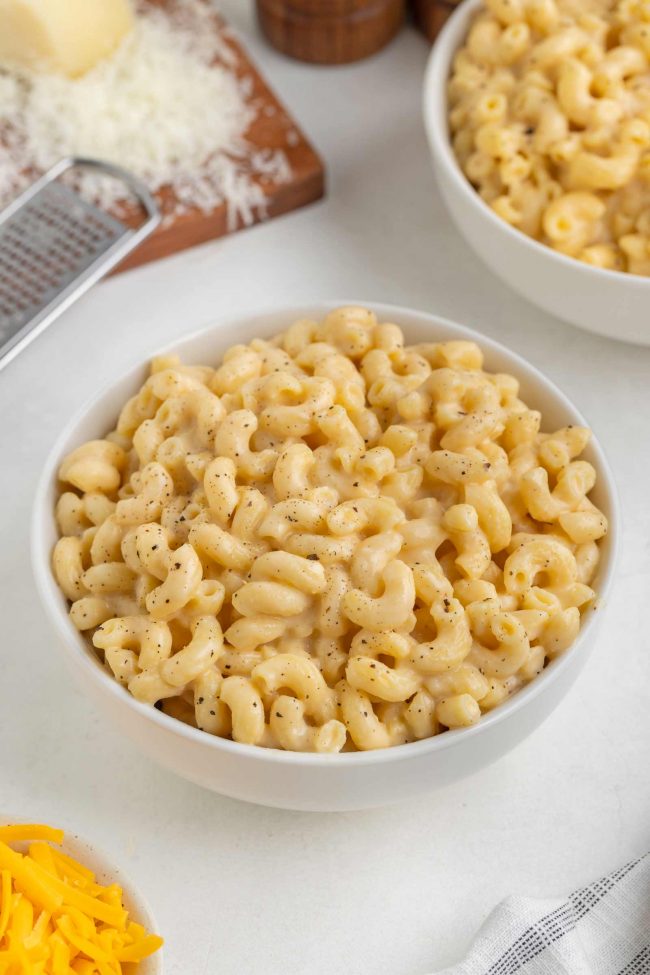
Instead of 1 cup of milk and 1/2 cup of cottage cheese, you need 1/2 cup of milk and 1 cup of Greek yogurt. And to make it less tangy, I added another 1/2 cup of cheddar.
You also need a third less cornstarch. So I guess only the pasta, garlic powder, salt and pepper amounts remained the same. I also added a bit of paprika to today’s version, which helped make it a bit less tangy.
The above picture makes it look like there’s not a lot of sauce. But there’s plenty.
Mac and cheese is always hard to photograph because it firms up so quickly. This is what it looks like when warm and fresh!
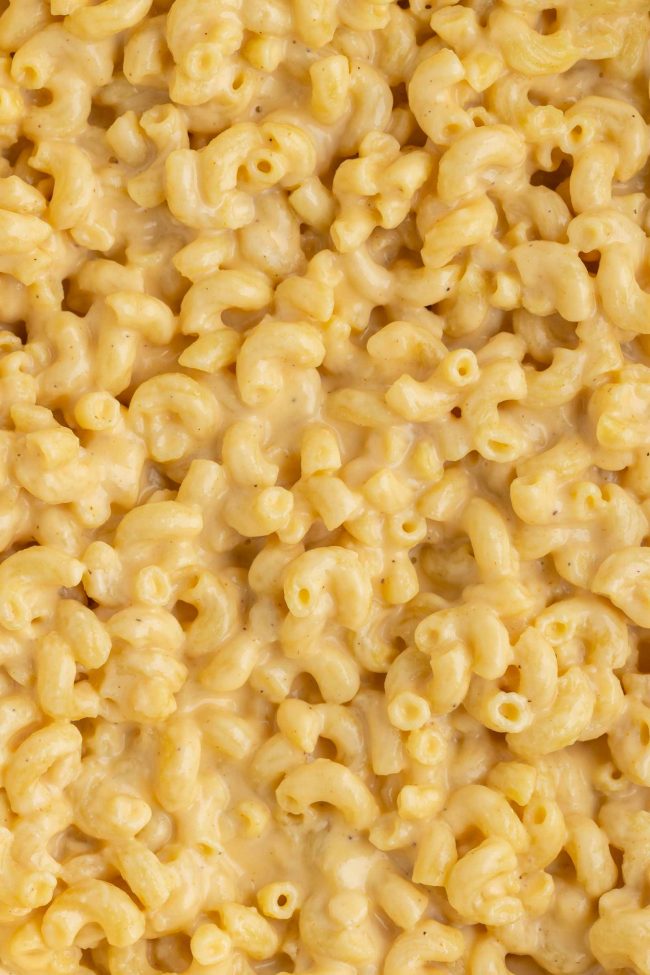
Ingredients
Here’s an overview of everything you’ll need. To get the full recipe, scroll down to the recipe box.
If you don’t want to use Greek yogurt, this Gluten-free Mac and Cheese is a more traditional recipe. And you can use whatever type of macaroni you’d like if you’re not gluten-free.
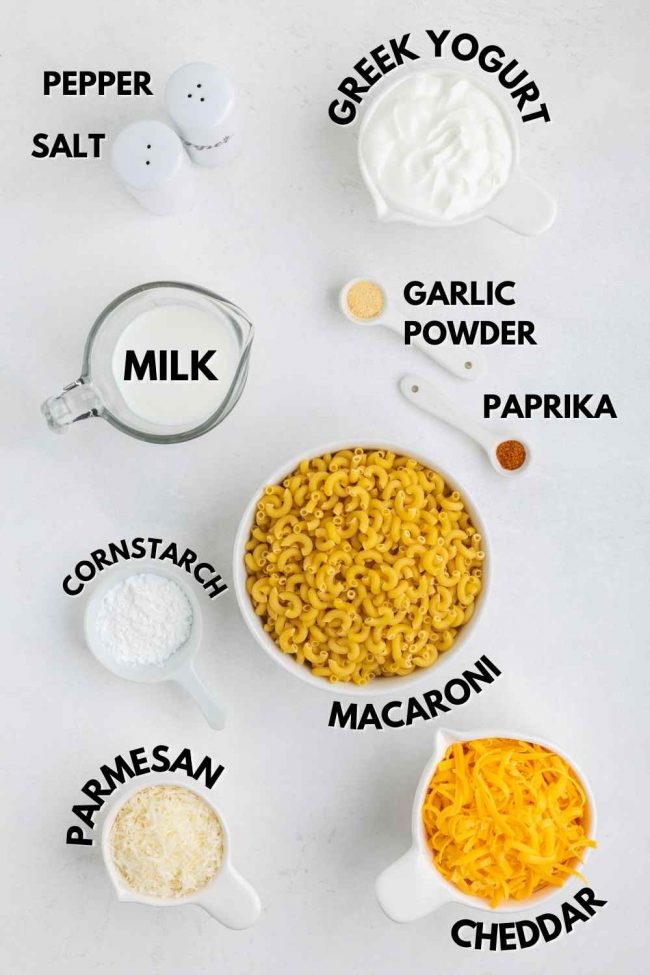
How to make it
Once the pasta is cooked, follow the directions for al dente pasta and drain it without rinsing.
Add the remaining ingredients to the pot and stir until it is smooth and thickened. Once the sauce is heated with no clumps of cheese, stir in the macaroni and serve.
I always add a dash of black pepper to my mac and cheese, but you can add any seasoning or herbs you’d like as garnish.
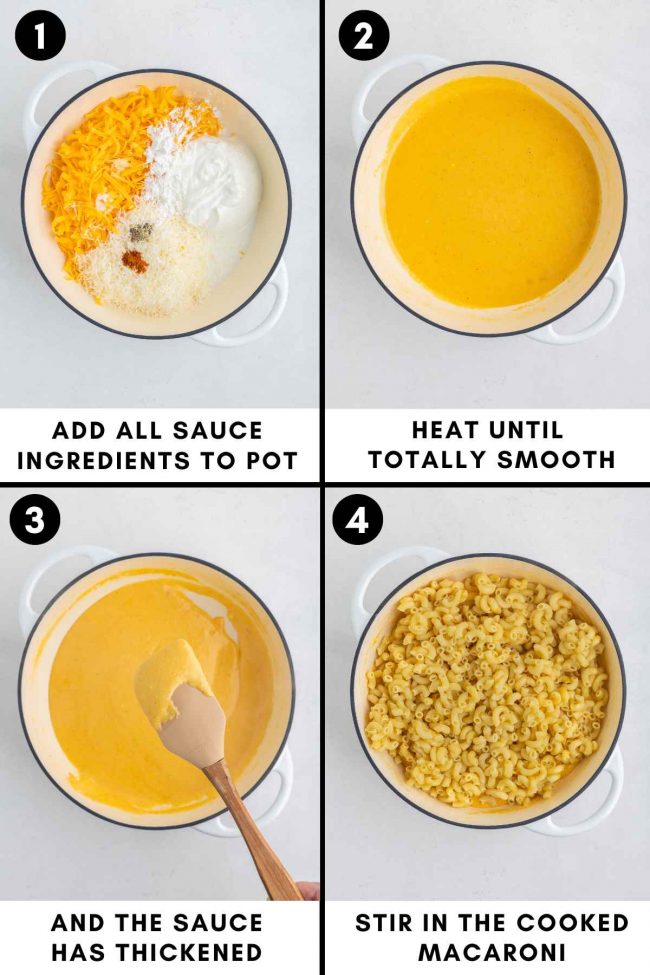
Why Greek yogurt?
Compared to the heavy cream found in traditional mac and cheese, Greek yogurt is an optimal substitute for achieving that creamy texture without the extra fat.
I tested this recipe with full-fat (10%) and low-fat Greek yogurt (I tried both 2% and 5%) and both worked. The photographer used Fage 2% in the photos, and it worked great.
She first used non-fat Chobani and said the cheese sauce came out grainy. We don’t have Chobani where I live, so I can’t test it myself.
So for now, I’m just going to recommend that you don’t use non-fat yogurt.
A cup of full-fat Greek yogurt typically contains around 20-25 grams of protein, depending on the brand and specific product. This amount can vary slightly based on factors such as the fat content and any added ingredients, but Greek yogurt is generally known for its higher protein content compared to regular yogurt.
Greek yogurt also has less water than regular yogurt, making for a thicker consistency, which is perfect for this mac and cheese.
Chickpea macaroni vs. regular
Chickpea pasta typically contains significantly more protein than regular wheat-based and gluten-free corn and rice-based macaroni. Chickpea pasta can contain around 20 grams of protein per serving, while traditional wheat-based or corn and rice-based macaroni usually contains about 7-8 grams of protein per serving. So, there’s roughly 2-3 times more protein in chickpea macaroni compared to regular macaroni.
In terms of taste, chickpea macaroni has a slightly nutty flavor due to the chickpea flour. It also has a firmer texture compared to traditional pasta. Some people find the taste and texture quite enjoyable, while others may need some time to adjust if they’re used to traditional pasta.
As for availability, chickpea pasta has become increasingly popular in recent years due to its higher protein content and gluten-free nature. You can often find it in well-stocked grocery stores, health food stores, and online retailers. It’s becoming more mainstream, so it’s relatively easy to find in many places.
I tried it for the first time in this mac and cheese. I really wanted to pack in as much protein as I could!
I don’t like chickpeas (I only use them for these chickpea cookies), so was surprised that I didn’t dislike it. In this dish, anyway.
I wasn’t a fan of it plain, but the cheese sauce did a great job of covering up most of the chickpea flavor.
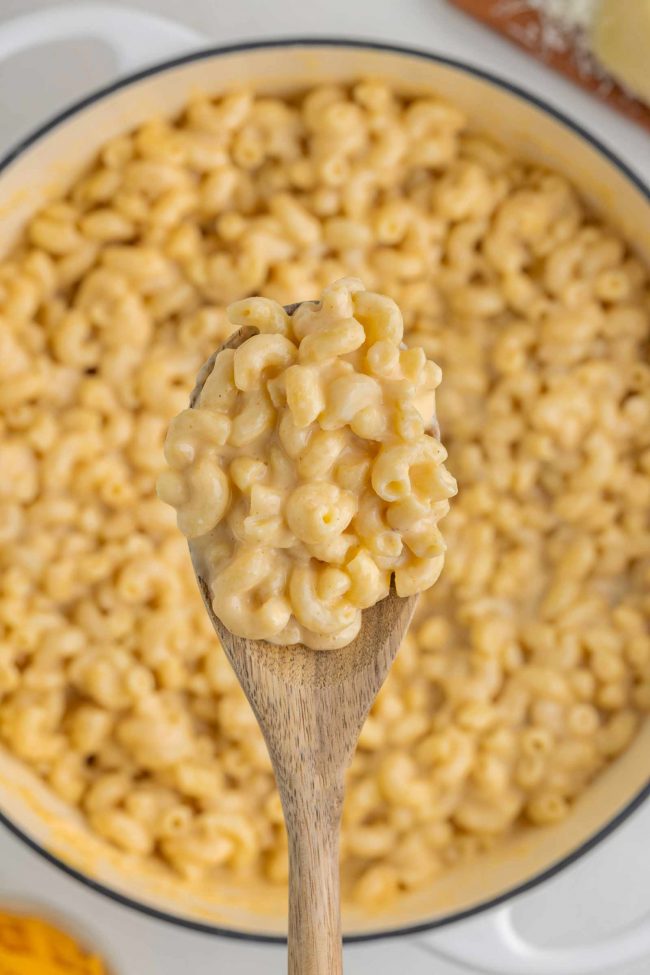
Al dente
You don’t want to overcook your macaroni when making mac and cheese. I like to cook pasta “al dente,” meaning there’s a little bite left in the macaroni. It’s not entirely soft, but it doesn’t have a lot of chew, either.
If the pasta directions don’t include “al dente” instructions, subtract one minute from the boiling time listed on the package.
Bring the water to a raging boil, add a good amount of salt, and then add the pasta.
There’s no need to rinse the pasta with water once it’s drained. The starch actually helps the sauce stick to the macaroni.
Cheese
To get the cheesiest mac and cheese, add freshly grated sharp cheddar cheese and Pecorino Romano or Parmesan with the remaining ingredients to get a smooth cheese sauce.
Pecorino Romano is my favorite hard cheese and is perfect in this mac and cheese. It’s sharper and saltier than Parmesan, but Parmesan also works well.
I don’t recommend using pre-grated cheese. While convenient, it often includes additives such as potato starch and natamycin to prevent the shreds from sticking together in the packaging.
Consequently, pre-shredded cheese may not melt as smoothly as cheese grated from a block. So grating your own is really best.
Cornstarch
Cornstarch is a great thickening agent, which helps achieve a smooth consistency and prevents separation of the cheeses.
Potato starch can be used as a 1:1 sub for cornstarch. It’s also neutral in flavor, which could work in the recipe.
Arrowroot won’t work here because it interacts with dairy-based sauces to make them slimy rather than thick and saucy.
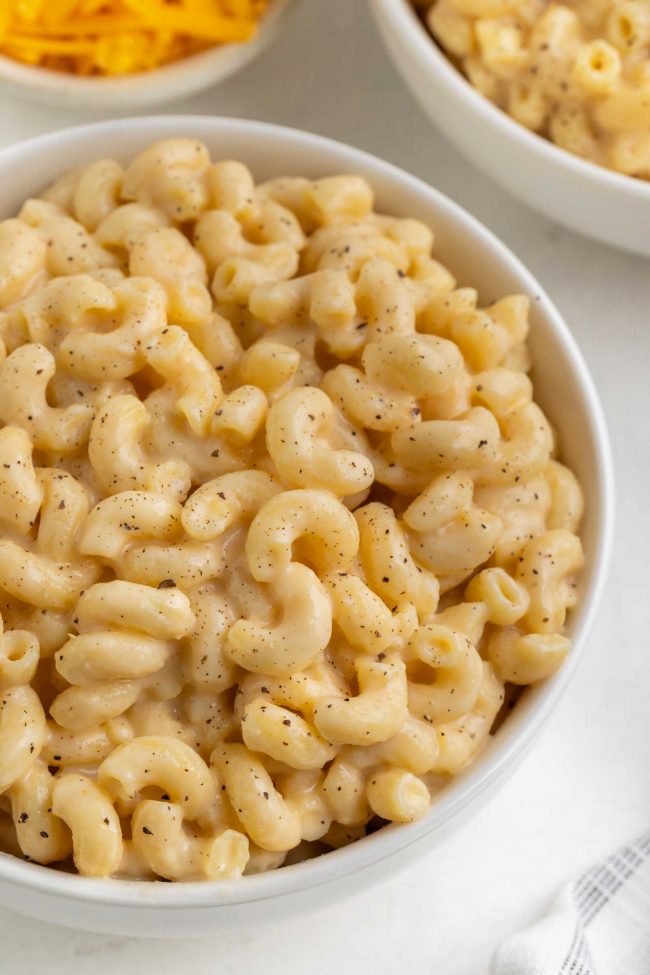
How to store
You can refrigerate this protein mac and cheese for up to 4 days in an airtight container.
I don’t recommend freezing. Freezing mac and cheese can alter its texture and taste.
When frozen and thawed, the macaroni can become mushy, and the cheese sauce may separate or become grainy. It’s best to enjoy mac and cheese fresh or refrigerate it for short-term storage rather than freezing it.
To reheat
Put the mac and cheese on the stovetop in a saucepan or skillet over low to medium heat and stir. I usually add a little milk to make it creamier.
If using a microwave, place it in a microwave-safe container, add a splash of milk or cream, and heat in short intervals, stirring between each to heat it evenly.
You can also heat it in the oven. Preheat the oven to 325 °F (163 °C). Put the mac and cheese in an oven-safe dish, add milk or cream and cover with foil, stirring occasionally until it’s evenly warmed.
No matter which method you use, avoid overheating it, as it’ll become dry and grainy.
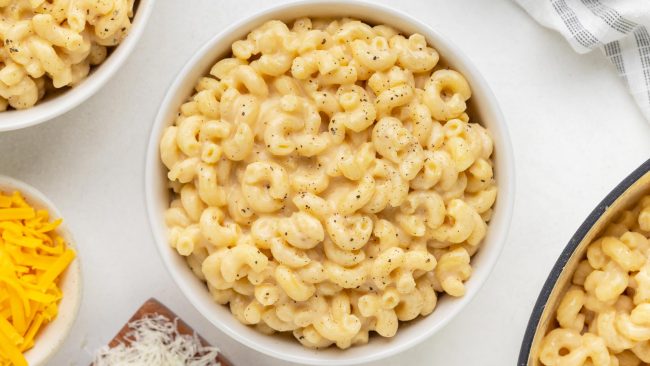
Gluten-free
First, use gluten-free macaroni pasta.
Plain Greek yogurt is usually gluten-free because it’s made of milk and live cultures.
But yogurt can come in many different types and flavors. Some may have anti-caking additives containing gluten or have been manufactured in the same facility where gluten-containing ingredients are processed.
If you’re very sensitive to gluten, you may want to find plain Greek yogurt that’s labeled as gluten-free. Here’s a list of gluten-free yogurts that are easy to find.
More pasta
I hope you’ll like this protein mac and cheese. If you try it, I’d love to hear what you think! Please leave a comment and enjoy. Thanks. :)
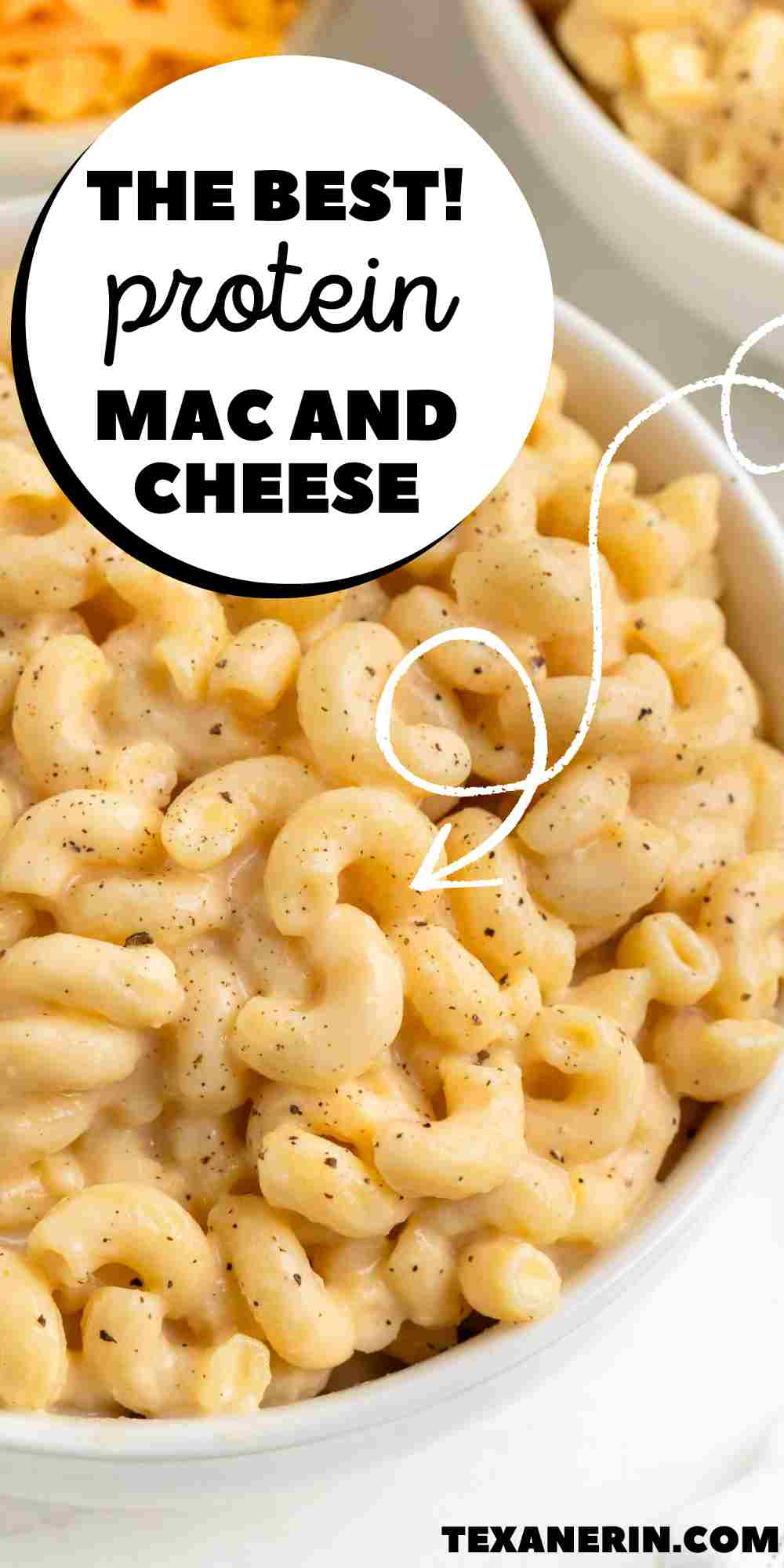
Protein Mac and Cheese
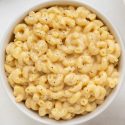
- Prep Time:
- Cook Time:
- Ready in:
- Yield: 6-8 servings
Ingredients
- 12 ounces (3 cups – 340 grams) elbow macaroni (if you're gluten-free, use GF macaroni)
- 1/2 cup (120 ml) whole milk
- 1 cup plain low-fat or full-fat Greek yogurt1
- 1 tablespoon (10 grams) cornstarch or potato starch
- 1/4 teaspoon salt (I used 1/2 teaspoon but like things salty)
- 1/4 teaspoon garlic powder
- 1/8 teaspoon black pepper + more as garnish
- 1/8 teaspoon paprika
- 1 1/2 cups (170 grams / 6oz) grated sharp cheddar cheese
- 1/2 cup (50 grams) grated Pecorino Romano or Parmesan cheese
Directions
- Cook the pasta according to the package directions for al dente. It’s important not to overcook it. Use a colander to drain the pasta but don’t rinse.
- Add the remaining ingredients to the pot (no need to rinse it), and stir until smooth and thickened.
- Add the cooked macaroni and stir until coated.
- Serve immediately. Leftovers can be cooled and refrigerated in an airtight container for up to 4 days.
Notes
- I tested this with full-fat (10%) and low-fat Greek yogurt (2-5%) and both worked. The photographer used Fage 2% in the photos, and it worked great. She first used non-fat Chobani and said the cheese sauce came out grainy. We don't have Chobani where I live, so I can't test it myself. So I highly recommend choosing low-fat or full-fat and not non-fat.






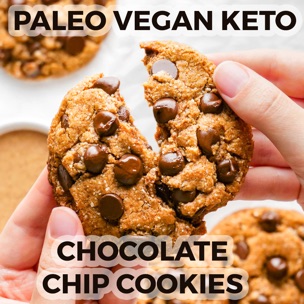
There are no responses on “Protein Mac and Cheese” — Be the first one!